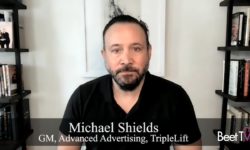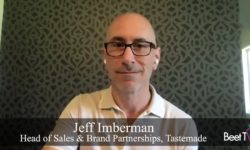In the last couple of years, the ad industry has undergone some of its most profound ever change.
New limits from privacy regulation and shifts in consumer behavior provoked by the rise in ad-free media are redefining advertising.
In this video interview with Beet.TV, Peter Sedlarcik, managing partner for Havas’ Media Group’s health practice, explains how things are changing.
Ads are getting shorter
“The form factor and the format of the ads, particularly from a TV and video perspective, has finally caught up to what consumer expectation is and what the market needs,” Sedlarcik says.
“I think for a long time, we’ve talked about 30-second (ads)… in healthcare, often 60-second or longer ads. We’re starting to see more of an embracement of shorter length units.
“As we’ve seen in the Olympics, for example, there were a lot more kind of interstitial, quick-hit, short-form ads that were inserted, not necessarily within a traditional commercial break. I think that there’s going to be more of that coming forward, not only in the linear TV platforms, but certainly in the CTV and other video platforms that are more consumer-controlled and on-demand.
Our latest @prosumer_report, ‘Health and Hygiene in the Post-COVID-19 Era,’ provides a cross-cultural perspective on reactions to the pandemic and explores the new expectations of Prosumers regarding #health, the medical community, and #brands. https://t.co/HUpvZF4p1j
— Havas (@Havas) April 29, 2021
Custom ads growing
Sedlarcik also says ad creative is more likely to be produced to match the delivery channel.
In other words, the age of shovelware may be drawing to a close.
“I think we’re starting to see more adaptation of creative so that it can be relevant for the platform on which it’s being delivered, and also that it’s very relevant for the audiences that it’s being targeted at,” he says.
https://twitter.com/HavasHealthYou/status/1380540542879162373
Creating more context
Havas relaunched its business serving health ad clients back in 2017 as Havas Health & You, uniting Havas Life, Health4Brands (H4B), Havas Lynx and Havas Life PR.
The agency has also responded to COVID-19 by seeking to become more agile. CEO Donna Murphy previously told MM+M: “Our business is moving into short snippets of content and movement so we have folks end-to-end going from writing, creative, shooting — delivering straight across. As we move forward the model will change quite dramatically.”
For Sedlarcik, the privacy wave also means an emergence from reliance on off-the-shelf consumer datasets.
“There’s more of a balance now between purchased based data sets that have been kind of preeminent in a lot of the planning that we’ve been doing as an agency… (and) contextual data sets,” he says. “Some of the partners that are really building out those assets are increasingly part of the conversation.


































